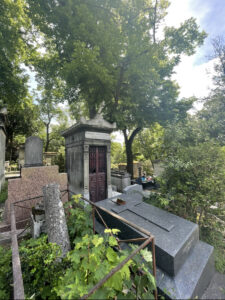A pleasant walk from the 11th Arrondissement to the 20th Arrondissement landed our NBB class at one of Paris’s most unique tourist attractions: Le Cimetiere du Pere Lachaise. Opened in 1804, it is the resting place of many famous people, such as Oscar Wilde, Eugene Delacroix, and Sarah Bernhardt. It attracts millions of visitors yearly, making it one of the most visited cemeteries in the world. Although I was skeptical of walking through a cemetery on a beautiful afternoon like today, it provided me and my fellow peers the perfect opportunity to explore and discover the hidden beauty of the cemetery.

Le Cimetiere du Pere Lachaise is not not only home to famous authors and actresses but also notable scientists. One famous scientist buried in this cemetery is Claude Bernard who made significant contributions to the field of neuroscience during the 19th century. Bernard was one of the first scientists to discover how the sympathetic nerve and chorda tympani are involved in vasoconstriction and vasodilation, respectively. Bernard also worked with antagonistic innervations and curare, a paralyzing agent, and found that it inhibits nerve stimulation of muscles, leading to research of asphyxia and anesthetics. Most importantly, his work with curare provided the basis of the neuron theory and laid the foundation for the future of neuroscience (Gomes & Engelhardt, 2014).
It is fascinating to learn about the history of neuroscience through the places we visit in Paris. I feel as if everywhere I look in Paris, there is a building or a monument or a statue that represents the history and culture of Paris. It is important to learn about scientists like Bernard because without him, the field of neuroscience would not be where it is today. Until Bernard’s research in the 1800’s, little was known about how the brain and muscles were connected. Now, there is technology such as the brain-machine interface that uses the electrical activity in the brain to guide a computer mouse or robotic limb.
Being able to see his place of burial puts into perspective how far neuroscience has come in the past 200 years. Bernard’s innovation at the time may have seemed preposterous, but with today’s discussion of head transplants in neuroethics, I’ve come to realize that no idea is ever too radical.

References:
Gomes, M. D., & Engelhardt, E. (2014). Claude Bernard: Bicentenary of birth and his main contributions to neurology. Arquivos de neuro-psiquiatria, 72(4), 322-5. https://doi.org/10.1590/0004-282×20130239
